Day 3 - The Serengeti
After a good night’s sleep, we were off on the safari trail. It was nice to leave our stuff in the rooms and know that we were coming back to the same place. We also would keep a much more relaxing pace given that we didn’t have as much ground to cover.
 We started off with a sighting of a pack of hyenas. These weird animals were following with us for a while. They really are crazed looking creatures and they looked like they were up to no good. One had an ear missing and they nervously moved off into the brush.
We started off with a sighting of a pack of hyenas. These weird animals were following with us for a while. They really are crazed looking creatures and they looked like they were up to no good. One had an ear missing and they nervously moved off into the brush.
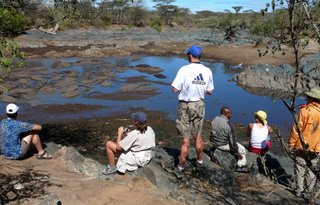 We continued on past giraffes, elephants, zebras and wildebeests to a hippo pool. This packed little place was cr
We continued on past giraffes, elephants, zebras and wildebeests to a hippo pool. This packed little place was cr
ammed with fat hippo bodies, various birds and a couple of crocodiles. We stayed for a few minutes watching what little movement there was and listing to the occasional snorts and grunts. When we’d had our fill of hippos we headed out past vervet monkeys and over to the grassy areas known to have cats.
 The weather was near perfect with plenty of sun and not too much heat. We were all scanning the brush and acacia trees for animals pointing here and there as we spotted them. At one poi
The weather was near perfect with plenty of sun and not too much heat. We were all scanning the brush and acacia trees for animals pointing here and there as we spotted them. At one poi
nt our road was cut off by a herd of migrating wildebeest and zebras. It’s a sight we’d see several times, even from our camp, bu
t it never seemed to get old. The wildebeest and zebras travel together quite often. Naimen was saying that the zebras actually take on herding responsibilities as the animals migrate south this time of year and then turn around and go back north some time in February. It was interesting at one point to see the zebras spot the “danger” of our safari vehicle and stop the herd. The wildebeest seem “intellectually challenged” and have no problems taking their cues from the zebras. A handful of zebras ran in front of the herd, did an about face giving the signal to the others to stop. It was pretty impressive to see nature’s organization – the zebras taking charge and the wildebeest’s happy obedience.
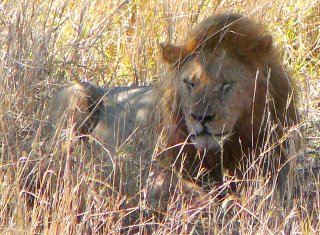 It wasn’t long before we came upon a line of safari vehicles
It wasn’t long before we came upon a line of safari vehicles
parked along a roadside. It was a good sign. Sure enough, as we approached we began to realize that not only was there a large, mature male lion in the shade of a tree, his buffalo carcass was lying a few feet away in the sun. It was a beautiful sight. The sleepy, well-fed lion with his head up and eyes mostly closed protecting what was left of last night’s dinner.
Buzzards were tempting fate as they desperately wanted leftovers. One of the more aggressive birds would ease towards the carcass only to be shooed back by the lion’s slightest movement. He’d simply tilt his head, open his eyes, move a paw, anything that might communicate to the birds that the powerful king of the jungle was not asleep and could, at any time, reduce them to a pile of feathers.
One of the amazing things about a lion that I was realizing while we watched in near silence, was the dramatic contrast that they embody. Here is a creature that resembles an innocuous house cat, not only in appearance but his casual demeanor. He licks his paws and then rubs his face. He squints as he seems to be fighting off sleep. He rolls over on his side as if he’s on your living room floor. I didn’t hear any purr but it would have seemed to fit the picture.
At the same time, this powerful creature weighed well over 400 lbs. and is one of the most powerful killers on the planet. They normally attack in groups with the females doing more of the work. They kill their prey by encircling it. When it makes a move to escape, the closest lion lunges for the victim’s throat and then it’s game over. It’s fascinating because, though you don’t see all of that violence in front of you, you know it’s there and lying a few feet away from our big, fluffy cat was the testimony of ravaged buffalo carcass.
We could have stayed longer but we needed to move on. We’d topped our crazy hyena viewing and were now ready for more. A short while later we were teased by the faint sight of a leopard in the bush. We were forced to use our imagination a bit since the animal was mostly obscured by brush and shade but it zoom lenses and binoculars attested to the fact that is was a beautiful leopard.
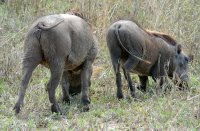 We moved on. It’s tough to capture the whole adventure since there was so much to see along the way. I’m focusing on just a few highlights in order to make this less boring and not so long.
We moved on. It’s tough to capture the whole adventure since there was so much to see along the way. I’m focusing on just a few highlights in order to make this less boring and not so long.
The next highlight was, for me, one of the big moments of the whole safari. As our safari vehicle moved further southwest, the brush thinned and the countryside began to have more of the look of the plains we had driven through the previous afternoon. There were still acacia trees here and there but there was more of the open spaces of tall wavy grass that seem to be a preferred habitat for the lions. Once again we saw a couple of safari vehicles parked near a couple of acacia trees not far from the road. As we approached our eyes followed the direction of those who had arrived before us – people like us who were poking up through the roofs of their safari vehicles.
 Sure enough, there in the shade of one of the acacia trees were four cheetahs. The mother was lying near the base of the tree and was barely visible. The three adolescents were all standing with their heads above the grass looking around. They were all clearly aware of our presence but unmoved by it. These animals had grown up with safari vehicles in their midst and though they are noisy at times and occasionally an object of curiosity, they are not seen as a threat. The strict park rules that vehicles must stay on the roads and that people may only leave the vehicles in designated areas help to make sure that this doesn’t change.
Sure enough, there in the shade of one of the acacia trees were four cheetahs. The mother was lying near the base of the tree and was barely visible. The three adolescents were all standing with their heads above the grass looking around. They were all clearly aware of our presence but unmoved by it. These animals had grown up with safari vehicles in their midst and though they are noisy at times and occasionally an object of curiosity, they are not seen as a threat. The strict park rules that vehicles must stay on the roads and that people may only leave the vehicles in designated areas help to make sure that this doesn’t change.
So the proud, beautiful cheetahs sat there in our presence. I honestly hadn’t anticipated seeing them since it’s not that common – certainly not this close to the road. I think they are one of the most impressive animals in existence. They are similar in appearance to the leopard but they have longer legs and their spots simply black. The leopard’s spots are more “rosettes” (a lighter colored spot within a spot). The cheetah also has two vertical black stripes on its face.
The cheetah is a true sprinter. It can reach speeds of up to 70 mph, faster than any animal it wants to eat. It has the endurance of a chain smoker, however, and must catch its prey within 300 meters. It must therefore get very close to its prey before launching the attack.
 After firing a couple thousand photos and just sitting and watching for a while, we moved on down the road. I was thinking around this time that this had already been more than I would have imagined. Just when you think it couldn’t get any better, it did. I was happy for the gang since they’d come all this way and I was hoping they wouldn’t be disappointed. All indication was that the safari rocked.
After firing a couple thousand photos and just sitting and watching for a while, we moved on down the road. I was thinking around this time that this had already been more than I would have imagined. Just when you think it couldn’t get any better, it did. I was happy for the gang since they’d come all this way and I was hoping they wouldn’t be disappointed. All indication was that the safari rocked.
 After another brief lion sighting (three or so), we stopped by the roadside to catch a glimpse of another leopard. This time it was high up in an umbrella acacia tree. The tree itself was beautiful but on the right side, tucked away mostly shaded was the elusive cat.
After another brief lion sighting (three or so), we stopped by the roadside to catch a glimpse of another leopard. This time it was high up in an umbrella acacia tree. The tree itself was beautiful but on the right side, tucked away mostly shaded was the elusive cat.
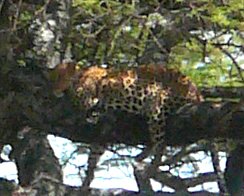 You could barely see it with the naked eye but my new 10x zoom allowed me to hone in on it pretty well. I’m not sure how these guides spotted these things as they drove along (seems pretty impossible) but my guess is they are familiar with their regular hangouts.
You could barely see it with the naked eye but my new 10x zoom allowed me to hone in on it pretty well. I’m not sure how these guides spotted these things as they drove along (seems pretty impossible) but my guess is they are familiar with their regular hangouts.
We angled off to a lunch spot not far from one of the three Serengeti airstrips. It was a visitors center with a dozen safari vehicles, loads of wazungu, several cement picnic tables and hundreds of scurrying mongooses (yes, that’s the plural) scrounging for snacks dropped from lunch boxes. Mom said the mongooses were simply rats and I’m not sure she was excited about their presence around our feet. I took a minute to look at them and look them up in my book. There were primarily two sorts: the banded mongoose and the dwarf. The former seemed to be aggressive and uninteresting but the latter captured my curiosity a bit more. It was tiny, as you might imagine, (the smallest of all African carnivores) but it had an interesting face. I might have taken some photos but some of our annoying tourist counterparts across the way were doing the same and I could bring myself to emulate them.
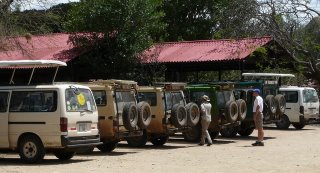 When we’d finished our snacks (don’t think I’ve ever eaten so many hard boiled eggs in my life), we continued on. I figured the afternoon would be short from a viewing standpoint. We’d had a full morning, eaten lunch late and I think that Naimen was going to shoot for us to be back at Ikoma Camp by around 4:00pm. I didn’t want to cut it too short since late afternoon lighting is the best and I also wanted to maximize this once-in-a-lifetime experience. There was talk of a night safari so I figured that cutting the day a bit shorter would be ok. I certainly wasn’t tired yet.
When we’d finished our snacks (don’t think I’ve ever eaten so many hard boiled eggs in my life), we continued on. I figured the afternoon would be short from a viewing standpoint. We’d had a full morning, eaten lunch late and I think that Naimen was going to shoot for us to be back at Ikoma Camp by around 4:00pm. I didn’t want to cut it too short since late afternoon lighting is the best and I also wanted to maximize this once-in-a-lifetime experience. There was talk of a night safari so I figured that cutting the day a bit shorter would be ok. I certainly wasn’t tired yet.
 Our first sighting was within a couple of minutes of lunch. There were some topis. These are in the antelope family but fairly large in size. They have a chestnut color with some black that makes them beautiful in the sunlight. We didn’t see that many and none that were as close as these next to the road.
Our first sighting was within a couple of minutes of lunch. There were some topis. These are in the antelope family but fairly large in size. They have a chestnut color with some black that makes them beautiful in the sunlight. We didn’t see that many and none that were as close as these next to the road.
We headed back by a hippo pool, different from the one earlier in the day, and slowly worked our way northwest towards our camp. Most of the afternoon was spent driving slowing without much stopping and seeing many types of animals we’d seen before. Part of the fun is just riding around with the breeze in your face, taking in the beautiful scenery, seeing the animals doing their thing and just simply enjoying being where you are and doing so in the company of your family.
At around 4:00pm we rolled into Ikoma Camp. We gathered in the café area, had a beer, talked about the day and showed off our digital photos to each other. Off in the distance you could see the wildebeests and zebras still working their way south in a steady stream. The sun had heated the water for the camp showers so I took advantage of it to wash off the day’s dust. We later regrouped around the fire pit, sharing it with some birders. Lisa made a failed attempt to chat with them but they were too engrossed in their books and note-taking. We overheard that they’d be joining us on the night safari later. My naïve hope was that they’d be more interesting by then.
Dinner was good again. Naimen came towards the end and discussed the plan for the next day. There wasn’t much too it. It was pretty much drive all the way back to Arusha without stopping much. We did decide to stop in a “boma”, one of the contrived Maasai villages set up for tourists. Otherwise, it would be full speed ahead.
This evening, however, we still had a 9:00-11:00pm night safari planned. We met at the fully open safari vehicle and the birders were already situated in the first of three bench seats. Curtis and I took the middle one and CJ, Brett and Lisa took the back one. We were a bit sleepy after dinner but as we were loading up to head out into the night it seemed that we were catching our second wind.
We had a driver and another guy who manned the spotlight. The plan would be to cruise around the area but not actually cross into the park since they were not authorized to do so. We were assured there’d be plenty to see and off we went. Within a few minutes from camp we saw a colorful chameleon which are actually pretty common. I’d played with them on several other occasions so I was anxious to get on to more exotic beasts. To my chagrin, our next stop was some sort of gray bird sitting on the ground. Our birder friends seemed fascinated by the little guy huddled under the intense spotlight. None of us know much about birds and we were not-so-secretly hoping that we’d move on pretty quickly.
Alas, the vehicle refused to re-start as the driver, under the orders of the birders, was going to drive around to see the color of the tail feathers. We were laughing our asses off at the whole comical scene: the dead safari vehicle in the middle of the dark bush, the spotlight guy who drained the battery even further by continuing to highlight the ugly bird while the driver attempted to re-start in vain, the birders using their headlamps to identify the annoyed little creature, etc. I don’t know if it was really THAT funny but for some reason it set the tone for a laugh-filled drive in the bush. We soon hopped out to push-start the safari vehicle (while the birders sat comfortably in their seats) and we were rolling again.
One by one we saw little creatures scurrying around in the beam of our spotlight. The bat-eared fox, the springhare, bushbabies, etc. were all pretty crazy looking creatures that I’d never seen before. On the horizon the orange moon had risen behind the silhouetted trees. The weather was cool and comfortable. Later on, off in the distance, we could see a fantastic lightning storm. It was pretty spectacular in that lightning was going off repeatedly for the entire safari until
after we were in bed.
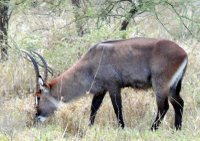




No comments:
Post a Comment